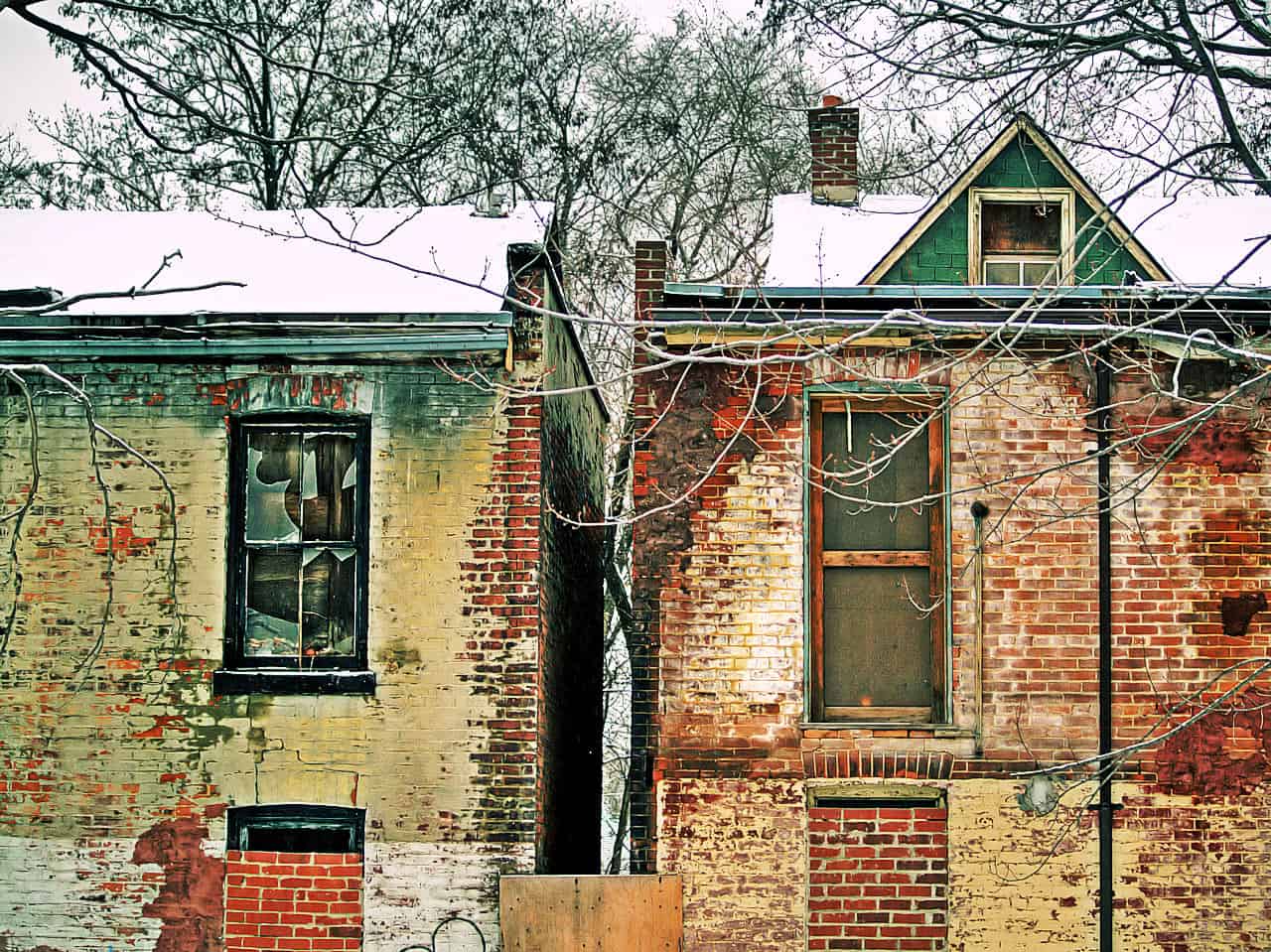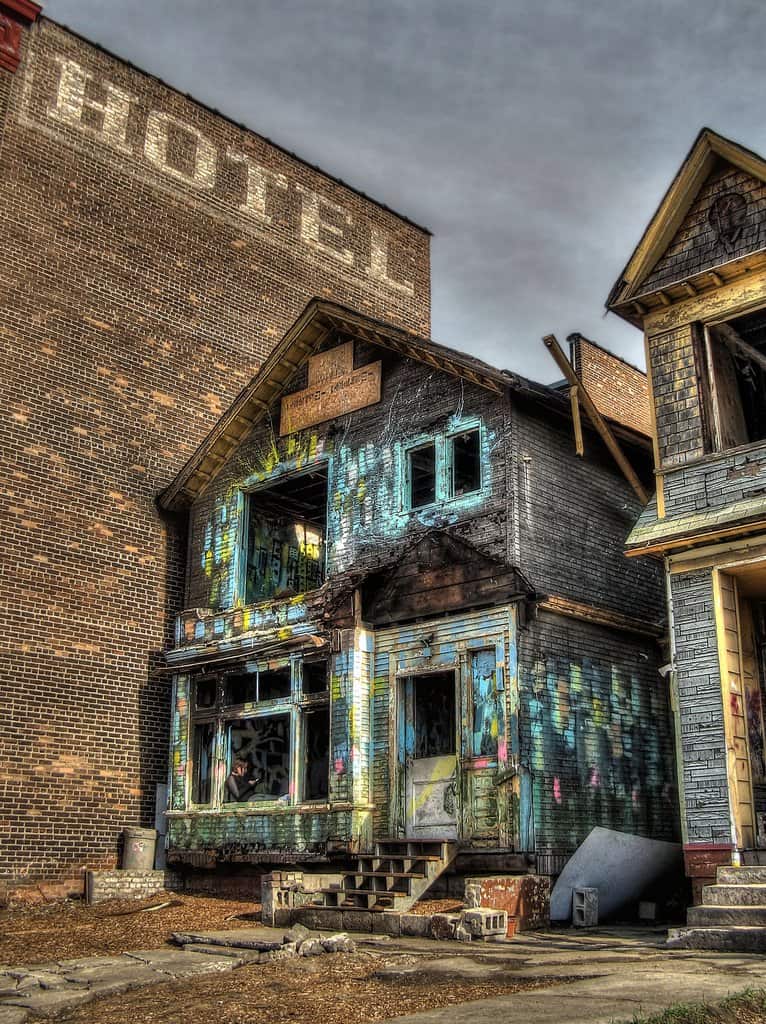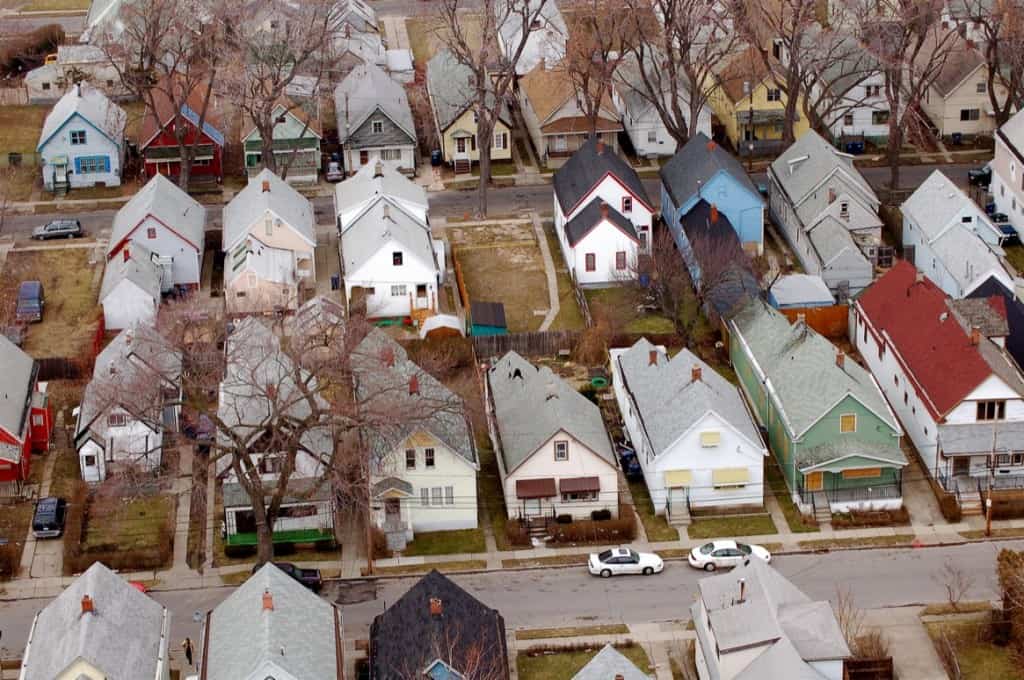I. When I was a graduate student, I lived in a dodgy neighborhood where gunfire was not uncommon. A few houses on my street were abandoned or unoccupied, and my own crumbling duplex had recently been a house of prostitution (or so I was told) before a slumlord reclaimed it for less shady occupancy. The rent was cheap, and my duplex only looked like a crack house from the outside. Inside it was newly painted, bright and livable, with a large living room where for many years my friends from grad school would stop by for good food, cheap booze, occasional pot, and loud, endless arguments about obscure literary matters. It was an awesome apartment.
II. It’s a little odd then that I didn’t remember my cozy old crack house when, a few years later, I was living in Detroit, during my first year as a Jesuit. I was helping out in a poor nursing home in a bleak section of the city. To get there, we drove through streets of abandoned row houses: falling-down, broken-glass shitholes. Yes, my reaction was this negative even though I had once lived in a duplex that had made my mother’s knees tremble when she first saw it. But there was a crucial distinction between these abandoned houses in Detroit and my old apartment. My apartment actually had functioning plumbing and heat, doors that locked, and windows that weren’t broken. So inside of my head, I had two lenses for seeing crack houses: an insider experience that saw a run-down duplex in a crappy neighborhood as an awesome place to live, and an outsider experience that saw them as shitholes.
III, IV. The steady decrease in American manufacturing combined with the urban riots of the 1960s struck Detroit with a double wallop from which it never quite recovered. One consequence of such problems was that abandoned houses took up huge swaths of land. Unlike other rust belt cities that slowly gentrified their old neighborhoods, it became impossible for Detroit neighborhoods to be reclaimed. And so those thousands of houses kept decaying – a vast, post-apocalyptic symbol of Detroit’s economic decline. The almost-innocuous practice of Devil’s Night in Detroit – a night of Halloween pranks and vandalism – became by the 1970s primarily a night of arson, in which disaffected youths saw the houses as kindling: raw materials for a night of law-breaking depravity. As a result of such large-scale arson, neighbors who lived immediately adjacent to such properties saw the abandoned houses as life-threatening and saw the disaffected youths as hoodlums.
V. But a sociologist might say that the burnings were a kind of protest – not only as an expression of those youths’ anger at their lack of educational and economic opportunity, but as a cut-rate way of doing the same thing the city was attempting, much less effectively, to do itself. Upstanding citizens of Detroit wanted to get rid of the buildings with permits, seizures, and bulldozers. The vigilantes were doing the same thing, only without the bureaucracy.
VI. A bishop from Africa was once driven around Detroit and shown the poorest sections of the city. When his host pointed out that the city was eager to tear down the abandoned homes in order to clear away the blight, the African bishop responded that his people would be lucky to live in such houses.1 From his perspective, those houses weren’t miserable hovels or dangerous bonfire-starters. They were shelters from the blazing sun and torrential downpours. Poor Africans who live in shanty towns or refugee camps, the bishop was suggesting, would be happy to have 2000 square feet per family, hard floors to sleep and walk on, and shelter from the heat and rain. Who cares about missing siding or broken windows? The bishop saw the world in terms of how he could clothe, feed, and house his flock. He saw the houses in a formalist sense: what they looked like in and for themselves, as if the houses existed anywhere, could be used for any purpose or be transported hither and yon, Detroit, Africa, the moon, wherever.
VII. Given the battle over meaning within the neighborhood (unlucky homeowners vs. restless youths), how would those charged with order, especially police officers, see those houses? They would understand that those neighborhoods have been and still are dangerous to live in. Even the homeless in Detroit prefer overcrowded shelters to the row houses. The homeless people who do find refuge in those abandoned houses risk not only the possibility of being burned alive as they sleep, but robbery, assault, and murder. So the question of whether such an abandoned house is livable (the bishop’s way of seeing it) is not just a matter of sweeping away the broken glass, covering the holes in the roof, and scrubbing away the cat piss. It’s primarily a question of safety. The bishop didn’t see the cultural context of those abandoned houses. Unfamiliar with the urban riots, or the cycles of poverty, gang wars and drug violence of the American scene, he didn’t know why or how the houses had come to be abandoned. The only thing he saw riding past in his car was shabby, if potentially usable, structures.
VIII. The tragedy of Detroit’s economic death spiral has been an opportunity for artists seeking to document the city’s decline and to explore in artistic form what such a diminishment means for America. Three recent books present photographic records of these projects: Andrew Moore’s Detroit Disassembled, Dan Austin’s Lost Detroit, and Yves Marchand and Romain Meffre’s The Ruins of Detroit. The latter is a sumptuously produced book of color photographs of crumbling Detroit, some of which can be seen on Marchand and Meffre’s website. Like the haunting pictures of the Titanic at the bottom of the sea, the photographs of Detroit’s wreckage are mesmerizingly beautiful. With their rich colors and textures, the photos make vivid not just the alternately subtle and weird tints of grimy factories and deserted hotels, but the loss and alienation such wrecks imply: a once-proud city that had been the hub of the booming automobile industry is in catastrophic decline. The pictures, in a word, are deeply ethical and empathetic in the ways they attend to the sadness of broken lives.
IX. But from yet another perspective, those pictures are neither aesthetically pleasing nor ethically compassionate. They are shamelessly exploitative. The photographs angered many citizens of Detroit, as well as some photography critics, who charged the artists with trafficking in “ruin porn.” Such photographs do not attend to people’s suffering; instead, they lie by making squalor seem sexy, reducing the city to nothing but a trash heap, and ignoring the bustling energy, the desirable neighborhoods, the hip downtown scene.
X, XI. So what do all these various perspectives add up to? I’m a teacher of rhetoric, and I’m used to getting inside of arguments and hopping around. But it’s important to note that I’m not a bishop or a cop or a photographer. I’ve never been homeless, and I’ve never visited Africa. I don’t have a degree in aesthetics or sociology. Yet in some manner – partly because of my experience and my reading, and partly because I am willing to do so – I can think myself into other ways of seeing. Experts, say historians or philosophers of aesthetics, might argue that I don’t explain their perspectives very well. But I’m not interested in being a master of every lens; I’m interested in the intellectual flexibility required for re-seeing something previously known from only one perspective.
Outside of the academy, one often hears condemnations of this kind of lens shifting – that it is either the consequence of or results in relativism, the belief that all perspectives are equally valid and that there’s no way of judging among them. The name that enemies (or friends) give to this phenomenon varies according to academic discipline, or according to who is doing the name-calling. With varying degrees of accuracy, it’s sometimes called relativism, nihilism, perspectivalism, postmodernism, or (hilariously off-the-mark) deconstruction. If there are thirteen ways of looking at a crack house, the enemies/friends of postmodernism say, then there’s no such thing as a crack house; it’s just an illusion constructed out of words rather than an instance of reality or an object with a definite quidditas. The name-callers who find postmodernism offensive are often self-described conservatives (political or religious), and whether their critiques are rigorous and thoughtful or hysterical and angry, this fight is one of the echoes of the culture wars that have been with us for the past 40 years. (Arguments about What Went Wrong at Vatican II, or Why Vatican II Is Awesome, or What Is the Spirit of Vatican II? are how Catholics play out their roles in the culture wars. Since there is a lot at stake in these arguments, it is why seemingly small issues, such as the translation of a Latin word, can open a gate onto this battleground.)
For the moment though, let’s ignore the arguments for or against postmodernism and consider instead the rhetorical force (rather than the philosophical truth) of the claim that postmodernism is the highway to meaninglessness. It is an odd stance to take because the complaint that such lens shifting leaves us morally or politically paralyzed doesn’t wash when you look at how arguments actually play out. The only people in the world who are actually rigorous relativists are people on the verge of suicide. Everyone else pretty much believes in something. Yes, you can probably walk into a philosophy department and find someone who claims that the search for meaning is absurd and that all perspectives are equally valid. But if you go to that same philosopher’s home and set her neighborhood aflame, she will not shrug her shoulders and cite Camus. She will call 911, or get the gun out of her closet, proving that she has very, very definite perspectives on any number of issues besides her personal safety.2 As Stanley Fish has been saying for years, your epistemology doesn’t have the slightest effect on how you move through the world.
There are intelligent philosophical critiques that show how perspectivalism does not necessarily lead to moral chaos. But the problem with such philosophical critiques (aside from boring everyone to death) is that critiques of critiques are always themselves subject to critiques, and we get lost in an infinite regress – an occasion for yet more tedious tit-for-tatting between right and left in the culture wars.3 And that’s not how rhetoric – philosophy’s unkempt, disreputable cousin – works. If philosophy is the place where abstract ideas dance in the heavenly firmament, then rhetoric is the brawling barroom where real-world arguments get worked out. In the heavens, the stars keep wheeling in their courses; in a bar, even if no one gets knocked out, the lights go off and the doors are locked at some point. Philosophy, in other words, has the luxury (and all the advantages) of endless conversation and analysis. Rhetoric, by contrast, is always trying to get things done with the available means and constraints.4
The various ways of seeing a crack house I’ve outlined above may all seem equally valid. But such an illusion only holds when those perspectives float inside of an academic or “philosophical” essay (like the one you’re reading right now). Which lens is right cannot be decided until those terms start duking it out inside of a rhetorical argument: historically, how did this neighborhood come to be abandoned and why? Politically, what should we now do with the houses? Artistically, how do we portray poverty and for what reasons do we do so? Economically, who should benefit from such exhibitions, displays, and book royalties? When what is at stake has such a clear rhetorical outline, then the grounds of the debate are relatively easy to find, though interlocutors will argue vociferously for control of those grounds.
XII, XIII. When he owned the crack house I lived in, my slumlord had only put in the barest amount of work to keep the building from collapsing. He was a nice enough guy and responsive to emergencies, but he only thought of the duplex as an income generator, not as an investment in the neighborhood.
When I drove past my old duplex a few years ago, I was not surprised to find that the neighborhood was still as scruffy as it had been ten years prior. But I found to my disappointment that the house had been painted. The sagging porch had been steadied. The house next door still looks like a crack house, but my duplex now looks like a respectable house of limited income. It means something important to its new owners.
Editor’s Note: Adapted here for TJP, a version of this essay will appear in Stayer’s forthcoming rhetoric textbook, co-authored with John Mauk and Karen Mauk, Think About It (Cengage).
— — — — —
- I have long ago forgotten who told me this anecdote. So I apologize if it has become garbled through time and memory. ↩
- For you philosophy nerds, here’s an anecdote to soothe your hearts: “He (Pyrrho) led a life consistent with his doctrine, going out of his way for nothing, taking no precaution, but facing all risks as they came, whether carts, precipices, dogs or what not, and, generally leaving nothing to the arbitrament of the senses; but he was kept out of harm’s way by his friends who…used to follow close after him. But Aenesidemus says that it was only his philosophy that was based upon suspension of judgment, and that he did not lack foresight in his everyday acts. He lived to be nearly ninety” (Diogenes Laertius, Lives of Eminent Philosophers, Bk IX, 62). ↩
- There are some who salivate at the chance to replay such arguments. I yawn and turn the newspaper to the crossword puzzle. And I hide from my Facebook feed friends – conservative or liberal – whose posts are primarily aimed at keeping score in the culture wars. (Their side always seems to be winning, of course.) ↩
- The snobbish (and false) binary between the supposedly pure methods of philosophical dialectic that lead to truth and the impure methods of rhetoric that lead to manipulation can be caricatured as follows: “Dialectic is what we do; rhetoric is what you do.” That’s what she said. ↩





